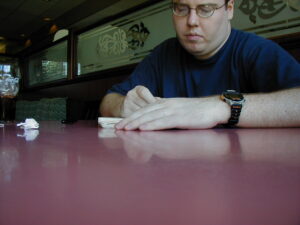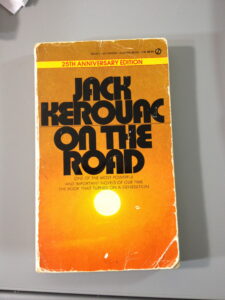I finished my next book yesterday.
26 pieces. 38,845 words. It has a title, but it may change.
I’m not really done done yet, because I have to come up with a cover (which I hate) and a book description (which I also hate) and maybe think about a new title. I also have to do the interior design, which is easy. But the text is done. It’s not getting any extra stories, and it’s not getting reworked to add in that alien abduction subplot or love story. It’s done.
The book is similar in structure to the last one, which means it was a clusterfuck to put together. This kind of book is essentially plotless, short pieces or cogs or lumps that are put together from smaller pieces, paragraphs torn from free-writes or inspired by tweets or built up from notes taken on a phone. The little scraps become big slices, and the slices get moved and rearranged and connected until they are big pieces. And then the big pieces are arranged and reordered and sometimes split back apart and cannibalized and dropped.
To give you an idea of how much cutting was involved, at one point a little over a month ago, the 38K word manuscript was just over 100,000 words.
My last book was done on 6/25/12, and this one was born soon after that. I actually had a few false starts on other things, ideas for books that fell apart after the outline stage. I keep these outlines, and maybe later one of them will get revisited and become an actual book or story. And I keep the scraps of writing that come out of them, and some of it ends up in other places. A sizable chunk of this book is made from pieces of a stalled book about alien abduction. Other parts are from an aborted book that examines my childhood in Indiana, which I stopped writing when I decided I didn’t want to write about childhood or Indiana.
The biggest drive on this book was to do another book similar to Rumored. That didn’t really happen, but I started chasing that this January, and kept at a daily writing quota. On 1/13 I had 47,252 words in this manuscript. On 4/3, I had 100,390. I wrote every single one of those days, even the days I was on vacation, off of work, or sick. There’s a piece of advice attributed to Jerry Seinfeld (although I can’t find the exact quote from him, just thirdhand references) that the best way to get shit done is to set a daily goal, and then mark each day on a calendar that you do the goal, and aspire to not break the chain by skipping a day. My initial goal was to stick with adding at least 500 words a day to this draft for a month, and I stretched that to almost three months before I shifted my focus from writing to editing. So in that sense, the book is already a success.
I didn’t write another Rumored, and I didn’t write my Infinite Jest. This book is about half the size of Rumored, and somewhere between my last two in length. I think that’s fine. But the eventual goal I keep chasing is to have a book that’s around 100,000 words long, and has a solid nonlinear structure, but still has enough plot to make people not freak the fuck out when they read it. It won’t be a fully-plotted murder mystery thriller thing, because there are enough of those out there, and that’s not what I do. I don’t know what that is, but it’ll happen.
I’m now entering the horrible postpartum depression that always follows when I finish a book. I always wonder if people will like a book after it’s done, and think about what should be next. I still have all of these release-related tasks, and I’ll probably play a lot of bass just to think about anything but writing. But I need to do some post-mortem and write down what did and didn’t work for this book, and then seriously start thinking about the next one. I have some vague ideas, but nothing solid. I need to get enough of an idea in front of me though that I can start up that Seinfeldian chain again.
Anyway, I’m happy to get the ninth notch carved in the wall. (Nine books written? Shit.) More news on what’s happening with it when I can tell you more – stay tuned.


